Growing production in Mexico and the US, along with rail wagon shortages, could disrupt the regional port network and its services. However, with new plants only just launching in Mexico, the future patterns aren't yet clear.
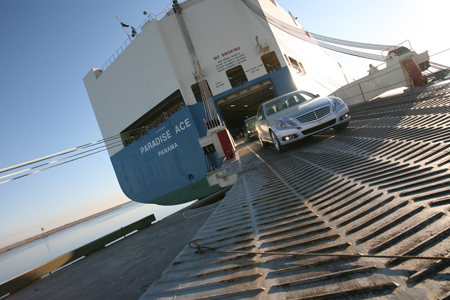
These are nevertheless a lot of ‘coulds’. Despite some chronic issues and disruptions this year, rail transport from Mexico to US remains, for many carmakers, a much speedier and efficient way of moving vehicles north. Mexican railways have planned substantial investments. And volume is not overloading capacity just yet. Our 2013 port-handing survey actually revealed an overall drop in volume at Mexico’s vehicle-handling ports last year compared to 2012. That could change with the start of production at new Nissan, Mazda and Honda plants this year – all of which are using short-sea for part of their exports to the US and Canada – however as all three will be in launch and ramp up phases for much of the year, volume will be unpredictable.
It is still beyond that point where the real questions lie. There is anticipation that Mexican production could grow by as much as 50% to 4.5m units by 2020. Sources say that 2.5m vehicles will arrive in the US and Canada from Mexico each year when production ramps up (last year, 1.8m vehicles were exported from Mexico to the US and Canada). Particularly in light of recent rail issues, that growth should open up more opportunities for short-sea shipping. Already, carriers including MOL, Höegh, WWL and others have been adding or exploring new services. However, seaports throughout the continent, and particularly in Mexico, will need to find ways to accommodate the increased volumes.
The growth in manufacturing within the US has also had an impact on the port network. North American light vehicle production rose 5% last year to reach 16.2m units, including 7% growth in the US to 11.14m. North American sales grew 4% to 18.4m, with US sales up 7% to 15.6m units. However, our survey showed growth of less than 1% across all participating ports in the region, as more demand was satisfied internally.
While the trend is not yet dramtic, there could be bigger changes ahead in the balance of trade, and thus the port network. For example, John Felitto, president and chief executive officer of the company’s processing subsidiary, WWL Vehicle Services Americas (WWL VSA), says that an increase in demand for exports from Mexico, along with a spike in demand for accessory installation for imports and exports in the US, has lead the company to explore potentially new vehicle processing locations, including in the US on the Gulf coast of Mexico. While Texas’s port of Galveston has a large flow of high-and-heavy cargo, the region is generally not a strong market for handling vehicles, except for Volkswagen in Houston.
“However, with Mexico’s export growth, we are studying the possibility of a vehicle processing operation there,” says Felitto.
Seeking options in Mexico
In Mexico, a drop in exports from Volkswagen, which lost production last year while retooling its plant in Puebla to start building the new Golf, contributed to a 20% fall in exports from the east coast port of Veracruz compared to 2012 (at around 750,000 units handled, the port was still the continent’s largest in overall volume). However, port capacity has also been a major issue, leading some manufacturers and shipping providers to seek out alternative export sites. On Mexico’s west coast, for example, developments and reorganisation at the port of Lázaro Cárdenas has led in part to a jump in exports by more than 60% compared to 2012.
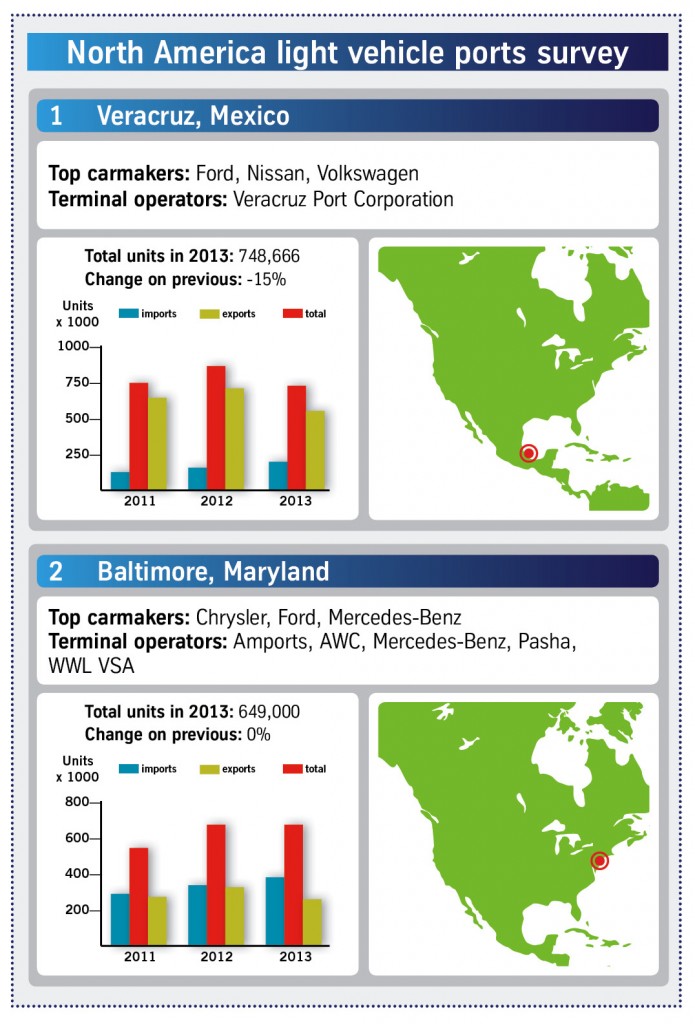
“Our shipments from the Celaya plant began in early April, and are twice monthly now. We are ramping up to weekly toward the end of the year,” says Manns. “Within 6-9 months, our ocean capacity will be much greater,” he reports, adding that Honda’s consistent volume at Lázaro Cárdenas helps with labour and equipment utilisation.
MOL offers a short-sea service on the US west coast that adds frequency to an existing service by Siem Car Carriers. Paul Carlton, president of MOL Bulk Shipping (USA) says that it continues to experience growth on the east coast. MOL currently uses three dedicated vessels between the US and Mexico. Its service frequency is now three to four sailings per month from Veracruz to Jacksonville, Brunswick, Baltimore, and Davisville.
Port capacity is a concern in Mexico along with the frequency of shipping services. One port that is set for further expansion is Lázaro Cárdenas. Vehicle processor and logistics provider SSA Marine, a subsidiary of Carrix, has bid for a concession to construct and operate what would be the first specialised ro-ro terminal in Mexico, according to Bob Wilder, vice-president marketing. SSA expects to offer 600 metres of waterfront area, two berths, and 40 hectares of yard space at Lázaro. However, a legal battle with terminal operator Amports has slowed the company's development after it won an earlier concession bid several years ago (Amports continues to operate a facility at the port as well). SSA started operations at the port this past October at a nearby terminal.
“The concession is expected to be awarded later this year. In the interim, we are working the ro-ro vessels at the nearby grain terminal facility,” says Wilder
SSA Marine also provides stevedoring and processing services at Veracruz, and is developing a new port terminal in Tuxpan, about 300km north of Veracruz. On the west coast, besides Lázaro, it operates at the ports of Manzanillo and Acapulco.
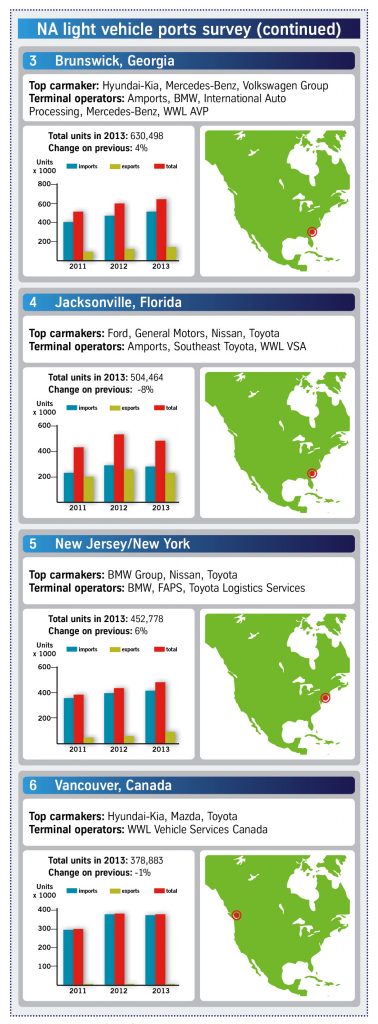 Click to enlarge
Click to enlargeAlong with its ocean and vehicle processing operations, WWL VSA manages rail services for customers, including Nissan across North America. “Rail capacity is the age-old issue when it comes to port-related challenges in Mexico,” admits Felitto.
The past few months have seen dramatic disturbances in North America following increased demand and winter weather that have slowed the network, impacting distribution, port flows as well as Mexican imports to some degree. Earlier this year, for example, Chrysler’s regular shipments to the port of Grays Harbour in Washington state were delayed by problems on the rail network, according to Stan Gabara, executive vice-president of business development and logistics at Pasha Automotive Services, which runs the port’s ro-ro terminal. As a solution, Pasha handled several export shipments from Chrysler through the port of Portsmouth, Virginia (a port which Gabara believes could also handle vehicles to and from other regions).
Elsewhere, rail issues for Chrysler led it to divert vehicles from rail onto short sea from Mexico to the US, including to Baltimore, says Martin Colbeck, Auto Warehousing Company (AWC) director of sales for the east coast.
On the whole, however, Mexico has fared better than the rest of the continent for rail this year, although there are concerns that capacity won’t keep up with demand in the medium term. “Rail transport is good in Mexico, but capacity is tight,” admits Felitto. “Everyone is concerned there will be a shortage of rail equipment,” he adds. WWL is working with carmakers to help ensure that empty rail equipment is readily available during times of peak demand.
The Volkswagen Group has historically used rail for around 55% of its exports from Mexico, with sea carrying the rest. Despite the rail issues this year, the carmaker has made no changes in its proportion of rail-based exports from Mexico, according to Ed Wilson, general manager of vehicle logistics for the Volkswagen Group of America. “We are trying to stay on rail; short sea is our backup,” he says. “Rail is more efficient because it provides a consistent, daily volume compared to larger, less frequent volumes by water.”
Wilson admits, however, that the company’s target of increasing speed to market has at times been hampered by tight port space, as well as constraints on rail and truck capacity. “Rail is backed up now, and we do not have the empties [rail wagons] that we need,” he says.
In response to such issues, Wilson says that Volkswagen is working more closely with ports – in North America it uses Veracruz, Houston, San Diego, Brunswick, Davisville, and Halifax – to improve its speed to market, including better communication. “It involves pre-ordering inventory for accessories and providing better labour forecasts to our transport providers,” he says.
Wilson adds that since January this year, Volkswagen began its quick allocation process for vehicles. “Every day, we provide the status of allocated cars that the port processors can ship, and we have increased our pace considerably,” he explains.
Strong in the southeast
Ports in the US southeast continue to see solid volume growth. Brunswick was the second largest US port in 2013 with 630,498 units, behind Baltimore’s 649,000 units. While the port is the largest in North America for imported vehicles, growing 4% in 2013 to more than 502,500 units, its exports increased by 7%, driven by demand in Europe and the Middle East, says Bill Jakubsen, global manager for ro-ro, bulk and general cargo at the Georgia Ports Authority. He points out that ocean carrier MOL began a weekly service from Veracruz to Brunswick in March; the Volkswagen Group and WWL also serve Brunswick from Veracruz.
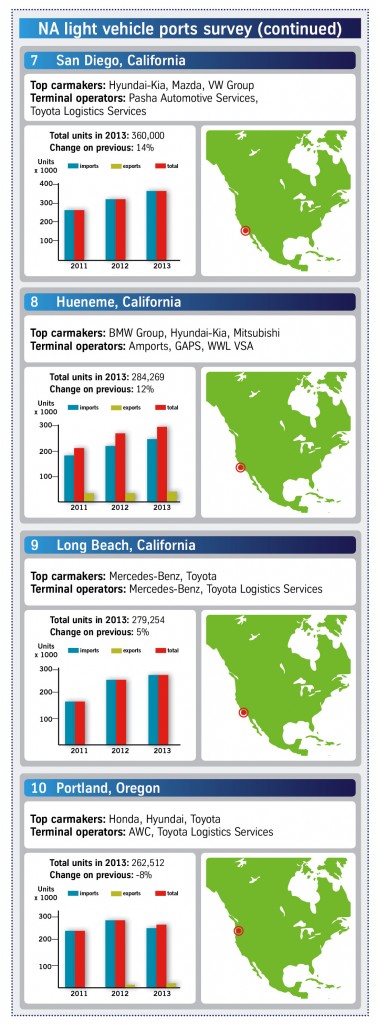 Click to enlarge
Click to enlargeFor its US exports, Nissan ships from Jacksonville, Brunswick, Savannah, and Hueneme. Hawkins anticipates that Nissan’s greatest export growth will be through the port of Brunswick, which should increase to 14,600 units in fiscal year 2014 compared to 4,600 in the same period for 2013. From the port of Savannah, Nissan’s volumes have been rising with the start of exports to Australia and New Zealand last year.
The port of Jacksonville is the fourth largest North American port, and third largest for exports. Roy Schleicher, executive vice-president and chief commercial officer, says that the port added Honda to its list of exporters last year. Ford and Nissan volumes have also increased. On the import side from Mexico, NYK Line is active in this trade to Jacksonville, along with MOL. Jacksonville’s Blount Island Terminal has made some infrastructure improvements late last year, including gate automation for its rail traffic, he adds.
The Volkswagen Group’s port growth has also been fastest in the southeast, including at Brunswick. The carmaker is in the midst of a tender for ports in the region, which are expected to see a big increase from Mexico once its new Audi plant starts production there in 2016. The company is considering established as well as emerging ro-ro ports. “We are bidding on a southeast port. In addition to Jacksonville, a number of ports are coming up, such as Tampa, Port Manatee, Port Canaveral, and the port of Virginia,” says Wilson.
Imports to the north
Some northeast ports have also reported gains in 2013, including the fifth-ranked port of New York/New Jersey, which handled more than 450,000 new vehicles. Baltimore also maintained its lead as the largest US port for vehicles, with strong growth in imports making up a decline in exports. AWC, which started operations in Baltimore last year, saw increased BMW imports at Baltimore, according to Colbeck, as well as from Fiat Chrysler, which is importing more vehicles from Serbia, Italy, and Turkey. Chrysler’s Baltimore exports are also on the rise.
“Space is limited, so we are turning a nearby building into a [vehicle] transformation centre,” he says. AWC expects to ramp up to full volumes by early June at its Baltimore operations.
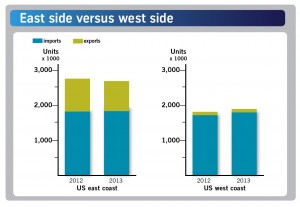
Far East by northwest
Overall, US west coast ports showed more growth in 2013 than those on the east coast did. This expansion included a 20% rise in exports, albeit from a much lower level than east coast ports. The bulk of that increase was from the port of Grays Harbor in the state of Washington, whose exports increased by 27% to more than 91,600 units thanks in large part to Chrysler volume. Grays Harbour also handles vehicles for Daimler Trucks and General Motors.
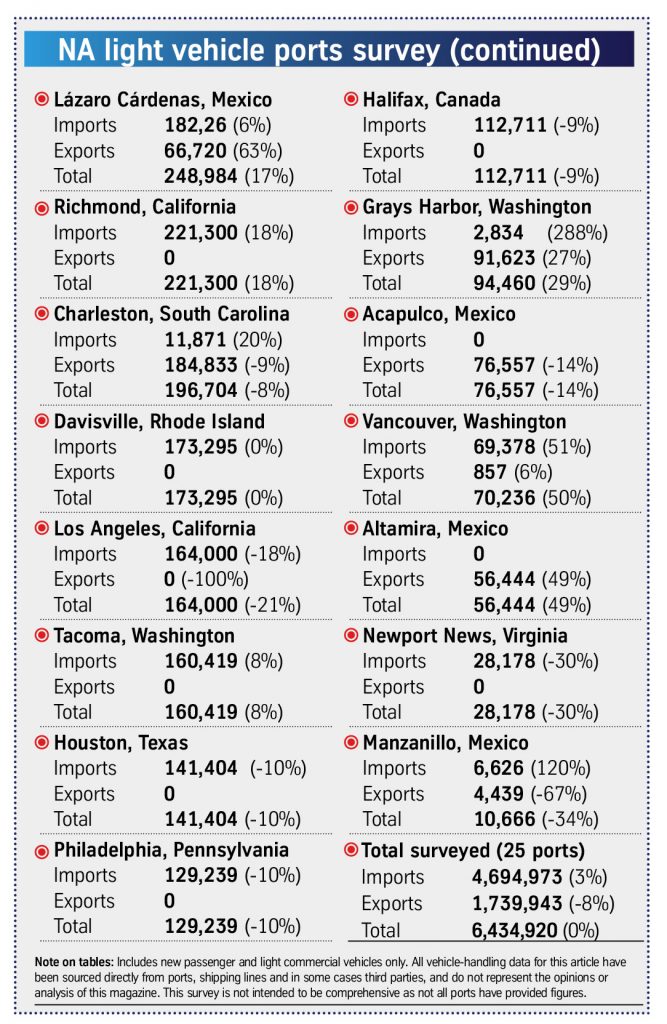 click to enlarge
click to enlargeOther ports in the northwest are showing export growth. At the port of Portland, vehicle exports to South Korea and China are on the rise. Exports to China began in October 2013, supported by a $2.8m expansion of AWC’s vehicle processing facility where it handles Hyundai imports and Ford exports. In the autumn 2013, AWC doubled its capacity so that it could handle Ford volume. It now operates a 27,000 sq.ft (2,500 sq.m) facility with capacity for 110,000 vehicles.
Already, Portland’s export figures through April 2014 were 11,478 units – more than for all of 2013, with full year expectations for 40,000 units, according to John Akre, Terminal Six manager. Ford made a
 Grays Harbor has invested in infrastructure improvements, including an automated car wash and more technical facilities
Grays Harbor has invested in infrastructure improvements, including an automated car wash and more technical facilities BNSF Railway handles both domestic and export shipments for Ford in Portland. “The challenge was how to handle exports land-wise. BNSF was running into bottlenecks,” says Akre. Portland recently sold 5.4 acres (2.2 hectares) to BNSF for expanding the railway’s 27-acre facility, which will improve its vehicle handling capacity, particularly for exports.
Akre says that Japanese imports have declined to Portland because of currency factors and production in North America. “We will lose some Hondas from Japan because production has shifted to Mexico. Portland was a national distribution gateway for Honda [from Japan], and will become a regional hub from Mexico,” he explains.
Some ports have already suffered as a result of the shifting production and trade patterns in North America. At the port of Los Angeles, Marcel van Dijk, business development manager, says that imports declined from nearly 200,000 units in 2012 to 164,000 in 2013. The main reason was increased production in the US and Mexico (particularly for Nissan), although he expects the port's volume to stabilise this year.
However, the area that may suffer most in the long run is Canada, as the country is hit by a strong Canadian dollar that make its exports to the US more expensive. Although the country has seen strong sales growth, production fell 4% last year to 2.37m and is expected to drop by another 25% by the end of the decade to 1.8m vehicles, according to forecasts by IHS Automotive.
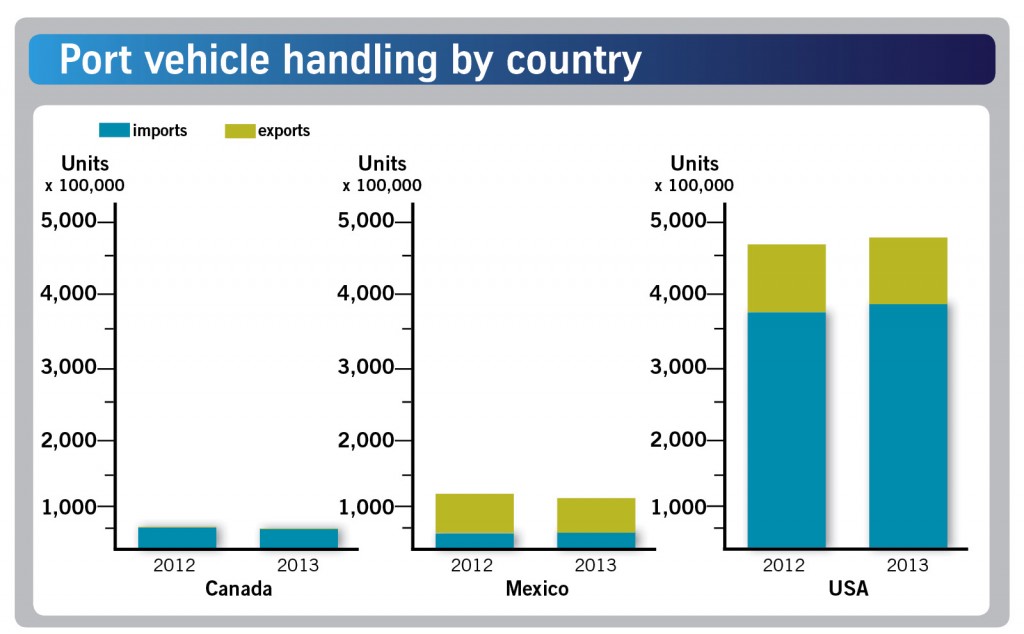
However, there are still gains to be made in Canada. Light vehicle sales reached a record level in 2013 at close to 1.75m; they are also up nearly 3% in the first five months of 2014 compared to the same period in 2013, including a record May. A free trade agreement with the European Union could eventually increase vehicle trade from Europe. Halifax, on the east cost in Novia Scotia, for example, is the closest North American port to Europe. It is also an important hub for Toyota.
More short-sea shipping from Mexico to the US would likely include more stops at Canadian ports as well, notably Halifax and Vancouver on the west coast. At Vancouver, this year has already seen changes. One of the terminal operators, Fraser Wharves, closed its terminal earlier this year. According to Felitto, WWL's Canadian subsidiary leased land from the port authority in Richmond, BC, which now servces the port as a satellite to WWL's existing terminal on Annacis Island. The company serves former Fraser Wharves customers from both locations. Vancouver currently handles ocean imports mainly from Japan and Korea.
In early 2013, WWL extended Annacis Terminal’s hours to a seven-day workweek to increase outbound shipments by rail, and reduce dwell time and inventory at the terminal. It added weekday evening shifts to increase capacity for accessory installations and vehicle yard processing. So there is plenty of growth potential. “However, without proper forecasting, there is a risk of service bunching and delays, or storage capacity limitations,” says Felitto.
Bright but uncertain future
In California, new vehicle imports saw relatively strong growth last year. The port of San Diego, the state’s largest for vehicle throughput, grew by more than 14% last year compared to 2012. Terminal operator Pasha Automotive Services’ imports are growing from Europe, Japan, Korea, and Mexico.

The news from North American vehicle ports is cautiously optimistic. Production and export patterns are changing shipping and port services, which could lead to losses in volume for some locations. Some ports are gaining from Mexico what they have lost from Japan, although the dominance of rail from Mexico could prevent further growth for ports. Nevertheless, the feasibility of short-sea shipments is gaining ground, and the degree to which ports and carriers react as exports increase could determine how much market share they will be able to take from rail providers.
Christopher Ludwig contributed to this report.


























![Global[1]](https://d3n5uof8vony13.cloudfront.net/Pictures/web/a/d/s/global1_726550.svgz)









